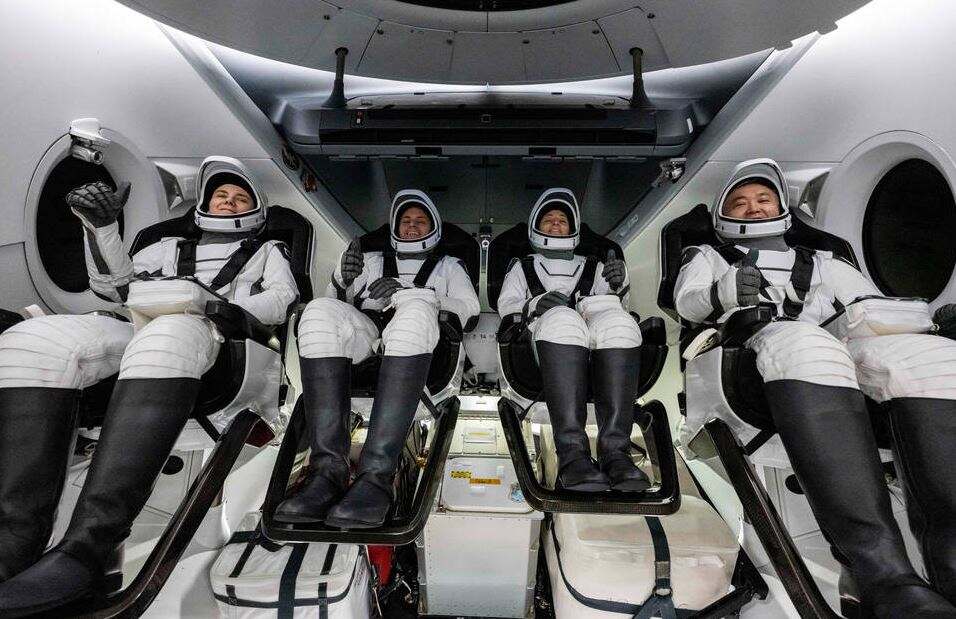Saturday marked the successful conclusion of the fifth commercial crew rotation mission to the International Space Station that was carried out by NASA’s SpaceX Crew-5. The astronauts successfully returned to Earth in their Dragon spacecraft, which they landed in a safe location off the coast of Tampa, Florida. A total of 157 days were spent in space by the multinational crew of four.
At 9:02 p.m. Eastern Standard Time, astronauts Nicole Mann and Josh Cassada of NASA, astronaut Koichi Wakata of the Japan Aerospace Exploration Agency (JAXA), and cosmonaut Anna Kikina of Roscosmos returned to Earth through a parachute-assisted splashdown. The spaceship and its occupants were brought back to Earth by crews onboard SpaceX recovery boats. Upon their arrival back on Earth, the crew will board a flight to the Johnson Space Center in Houston, which is operated by NASA.
The Falcon 9 rocket that was used for the Crew-5 mission took off from the Kennedy Space Center in Florida at twelve o’clock noon Eastern Daylight Time on October 5, 2022. After a little over 17 hours, the Dragon successfully docked to the forward-facing port on the Harmony module. By 2:20 a.m. on Saturday, the crew disembarked from the same port in order to continue the journey back home.
Throughout the course of their mission, Mann, Cassada, Wakata, and Kikina travelled a total distance of 66,577,531 miles, spent 156.5 days onboard the space station, and performed 2512 orbits around the Earth. Mann, Cassada, and Kikina all had their first trip into space during the Crew-5 mission. During the course of his five trips into space, Wakata has racked up a total of 505 days.
Throughout the course of their mission, the crew members of Crew-5 participated in a variety of scientific and maintenance endeavours as well as technological demonstrations. Along with NASA astronaut Frank Rubio, Cassada participated in three spacewalks during which the International Space Station Roll-Out Solar Arrays (iROSAs) were installed and preparations were made for two further iROSAs. Both Mann and Wakata participated in two spacewalks together, during which they also outfitted the orbiting laboratory with additional solar arrays.
In addition, the crew members studied how liquids move in a container in simulated lunar gravity in order to generate data that can be used to improve Moon rover designs, tested an on-demand system to produce specific quantities of key nutrients from yoghurt, kefir, and a yeast-based beverage, and grew plants without using soil using hydroponic and aeroponic techniques. They also released the first satellites for the countries of Uganda and Zimbabwe. Additionally, the astronauts grew dwarf tomatoes in an effort to address the need for a continuous fresh-food production capability in space. In the long term, the goal is to produce whole human organs in space.
The Dragon spacecraft, which was given the name Endurance by the astronauts of Crew-3 on its first mission, successfully completed its second mission. Endurance will go back to Florida for processing and inspection at SpaceX’s Dragon Lair. There, workers will check the spacecraft, examine data on its performance, and prepare it for its subsequent mission.
The Crew-5 mission is a part of NASA’s Commercial Crew Program, and its return to Earth comes on the heels of the launch of NASA’s SpaceX Crew-6, which docked to the station on March 3 to begin another science expedition. The Commercial Crew Program is a partnership between NASA and private industry.
Transportation to and from low-Earth orbit and the International Space Station in a manner that is safe, dependable, and as economical as possible is the objective of the Commercial Crew Program run by NASA. This is already giving more time for study, and it has enhanced the chance for discovery onboard humanity’s microgravity testbed for exploration. This is helping NASA prepare for human exploration of the Moon and Mars, among other things.
